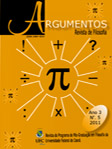Genius and nature in judgment criticism
Keywords:
Genius. Nature. Art.Abstract
We propose a relationship between the notion of genius from the Critic of Power of Judgment and the introductions of the same work that says about the faculties system of knowledge and spirit. We know about the insuperable gulf between the theoretic domain and the practical domain of philosophy. The Konigsberg’s philosopher devises a building between the two hills, but only about a subjective and critic system. The judgment faculty appears like an a priori law maker, but it’s different from the determinate laws from understanding. The judgment is only reflective, because it finds the law of contingents, about the empiric particular laws. In the analytic of beauty, the law of contingent is founded by the arid concept of form of finality that makes a beautiful object into an example, and not a general law. The form of finality is seeing in the Nature only from the technical (artistic) point of view. The genius is endowed with a productive faculty whose works is called beautiful art that Kant compares with the Nature. The beautiful art looks like a nature object. So, we sustain that the analogy is only possible if we think about Nature considered in the technical point of view whose laws are found in the contingent and in the example.Downloads
Published
Issue
Section
License
Argumentos magazine is licensed under an International Creative Commons Attribution License.
The Magazine uses CC BY inclusion
1) The authors retain the copyright granted to the magazine or the right to initial publication, with the work regularly licensed under the Creative Commons Attribution, which allows the sharing of the work with acknowledgment of authorship and initial publication in this magazine.
2) The authors are authorized to contract additional applicable contracts, for non-exclusive distribution of the version of the work published in this journal (for example, publication in the institutional repository or as a chapter of the book), recognition of authorship and initial publication in this journal.
3) Authors are authorized and encourage to publish and distribute their work online (for example, in institutional repositories or on their personal pages) at any time before or during the editorial process, as they can generate productive changes, as well as increase the impact and reference of published work.




.jpg)










._._3.png)
1.jpg)
._._._.png)
